Interaction of Tropical Easterly Jets over North Africa
Abstract
1. Introduction
2. Data and Methods
3. Results
3.1. Climatology and Inter-Annual Characteristics
3.2. Composite Difference Maps and Sections
3.3. Intra-Seasonal Features and August 2018 Case
4. Summary Discussion
Funding
Acknowledgments
Conflicts of Interest
Appendix A
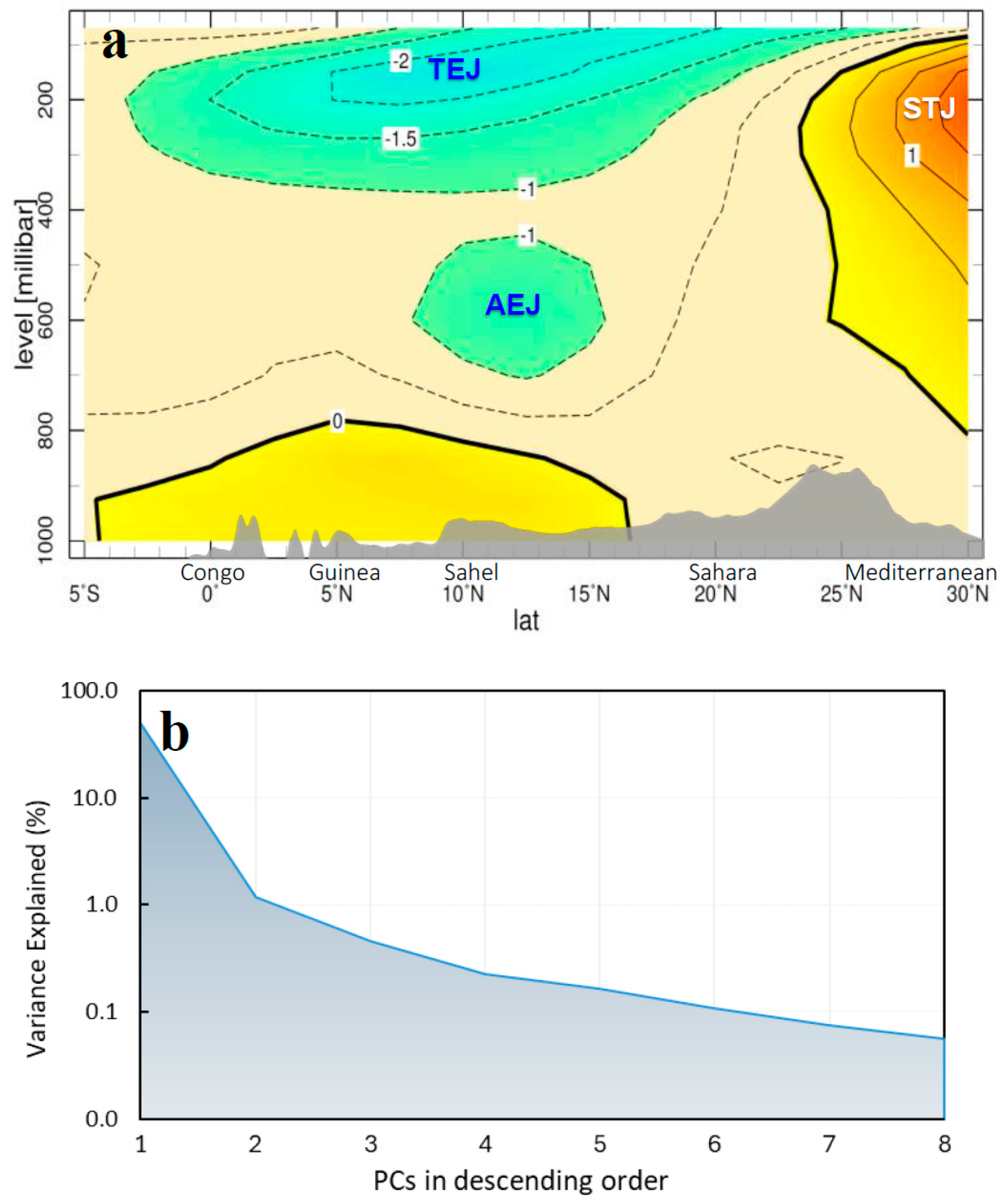
References
- Sathiyamoorthy, V.; Pal, P.K.; Joshi, P.C. Intra-seasonal variability of the tropical easterly jet, Meteor. Atmos. Phys. 2007, 96, 305–316. [Google Scholar] [CrossRef]
- Webster, P.J.; Fasullo, J. Monsoon dynamical theory. Encycl. Atmos. Sci. 2003, 3, 1370–1386. [Google Scholar] [CrossRef]
- Huang, S.; Wang, B.; Wen, Z.; Chen, Z. Enhanced tropical eastern Indian Ocean rainfall breaks down the tropical easterly jet–Indian rainfall relationship. J. Clim. 2021, 34, 3039–3048. [Google Scholar] [CrossRef]
- Thorncroft, C.D.; Blackburn, M. Maintenance of the African easterly jet. Q. J. R. Meteorol. Soc. 1999, 125, 763–786. [Google Scholar] [CrossRef]
- Hsieh, J.-S.; Cook, K.H. Generation of African easterly wave disturbances: Relationship to the African easterly jet. Mon. Wea. Rev. 2005, 133, 1311–1327. [Google Scholar] [CrossRef]
- Leroux, S.; Hall, N.M.J. On the relationship between African easterly waves and the African easterly jet. J. Atmos. Sci. 2009, 66, 2303–2316. [Google Scholar] [CrossRef]
- Leroux, S.; Hall, N.M.J.; Kiladis, G.N. A climatological study of transient–mean-flow interactions over West Africa. Q. J. R. Meteorol. Soc. 2010, 136, 397–410. [Google Scholar] [CrossRef]
- Spinks, J.; Lin, Y.-L. Variability of the subtropical highs, African easterly jet and easterly wave intensities over North Africa and Arabian Peninsula in late summer. Intl. J. Climatol. 2014, 35, 3540–3555. [Google Scholar] [CrossRef]
- Sultan, B.; Defrance, D.; Iizumi, T. Evidence of crop production losses in West Africa due to historical global warming in crop models. Sci. Rep. 2019, 9, 12834. [Google Scholar] [CrossRef] [PubMed]
- Mekonnen, A. Synoptic-Scale Convection and Wave Activity over Tropical Africa and the Atlantic. Ph.D. Thesis, State University of New York, Albany, NY, USA, 2007. [Google Scholar]
- Nicholson, S.E. On the factors modulating the intensity of the tropical rainbelt over West Africa. Intl. J. Climatol. 2009, 29, 673–689. [Google Scholar] [CrossRef]
- Spinks, J.; Lin, Y.-L.; Mekonnen, A. Effects of the subtropical anticyclones over North Africa and Arabian Peninsula on the African easterly jet. Intl. J. Climatol. 2014, 35, 733–745. [Google Scholar] [CrossRef]
- Lemburg, A.; Bader, J.; Claussen, M. Sahel rainfall-tropical easterly jet relationship on synoptic to intraseasonal time scales. Mon. Weather Rev. 2019, 147, 1733–1752. [Google Scholar] [CrossRef]
- Preethi, B.; Sabin, T.; Adedoyin, J.; Ashok, K. Impacts of the ENSO and other tropical climate-drivers on African rainfall. Sci. Rep. 2015, 5, 16653. [Google Scholar] [CrossRef] [PubMed]
- Huang, S.; Wen, Z. Diversity of the tropical easterly jet’s core location. Environ. Res. Lett. 2024, 19, 074027. [Google Scholar] [CrossRef]
- Liu, S.; Huang, S.; Tan, Y.; Wen, Z.; Chen, X.; Guo, Y. Characteristics and mechanisms of the interannual variability of the Northwest–Southeast shift of the tropical easterly Jet’s core in July. J. Clim. 2024, 37, 3219–3235. [Google Scholar] [CrossRef]
- Gelaro, R.; McCarty, W.; Suárez, M.J.; Todling, R.; Molod, A.; Takacs, L.; Randles, C.A.; Darmenov, A.; Bosilovich, M.G.; Reichle, R.; et al. The modern-era retrospective analysis for research and applications, v2 (Merra2). J. Clim. 2017, 30, 5419–5454. [Google Scholar] [CrossRef] [PubMed]
- Reynolds, R.W.; Smith, T.M.; Liu, C.; Chelton, D.B.; Casey, K.S. Daily high-resolution blended analyses for sea surface temperature. J. Clim. 2007, 20, 5473–5496. [Google Scholar] [CrossRef]
- Penny, S.G.; Behringer, D.W.; Carton, J.A.; Kalnay, E. The hybrid global ocean data assimilation system at NCEP. Mon. Wea. Rev. 2015, 143, 4660–4677. [Google Scholar] [CrossRef]
- Lee, H.-T. Climate Algorithm Theoretical Basis Document: Outgoing Longwave Radiation (OLR); NOAA’s CDR Program, CDRP-ATBD-0526; NOAA Climate Data Record Program Office: Asheville, NC, USA, 2014; 46p. [Google Scholar]
- Funk, C.; Verdin, A.; Michaelsen, J.; Peterson, P.; Pedreros, D.; Husak, G. A global satellite-assisted precipitation climatology. Earth Syst. Sci. Data Discuss. 2015, 8, 25. [Google Scholar] [CrossRef]
- FAOstat. Aggregated Crop Yield over the Sahel. 2025. Available online: https://www.fao.org/faostat/en/#data/QI (accessed on 1 May 2025).
- White, W.B. Tropical coupled Rossby waves in the Pacific ocean–atmosphere system. J. Phys. Oceanogr. 2000, 30, 1245–1264. [Google Scholar] [CrossRef]
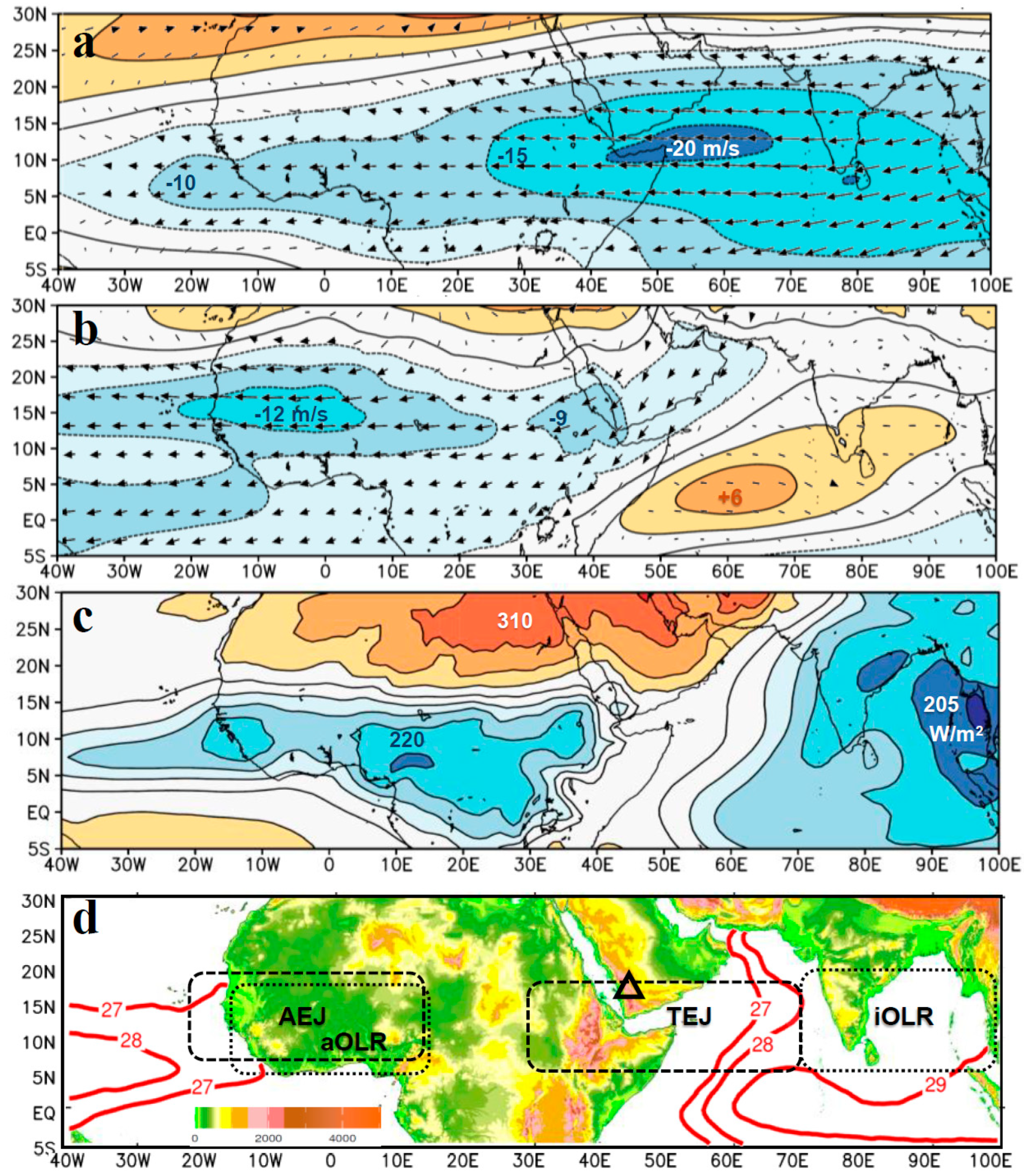

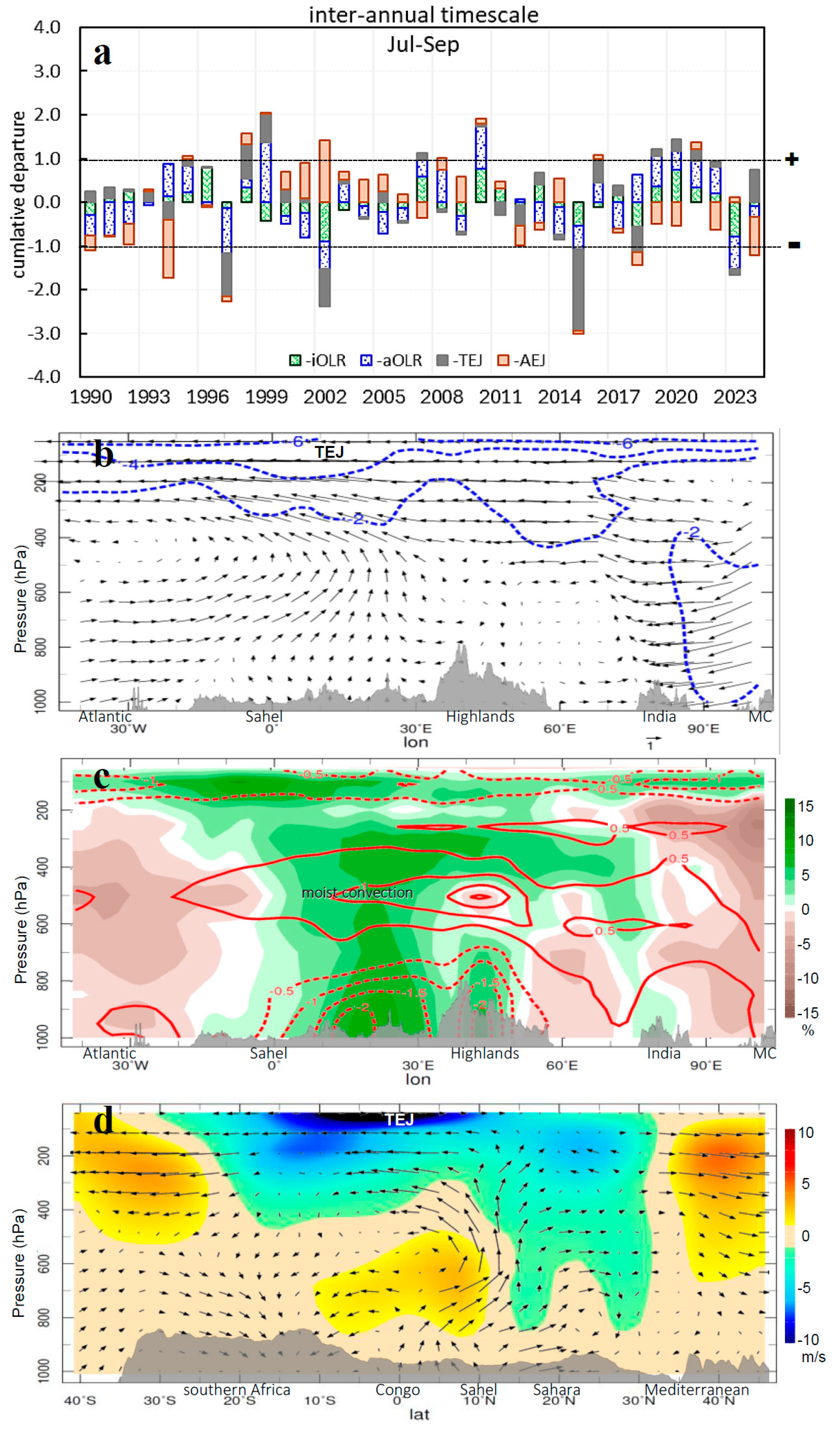

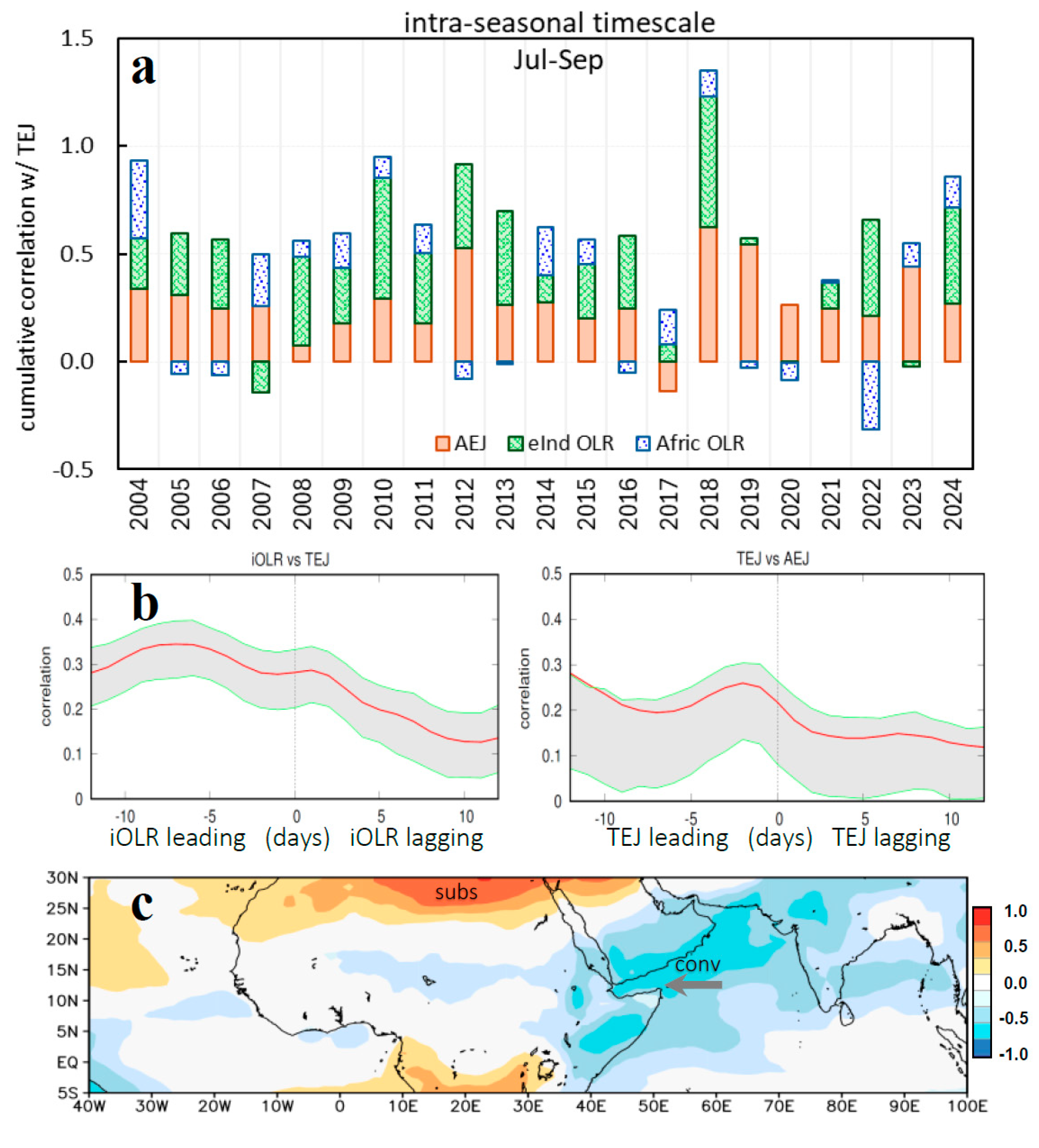

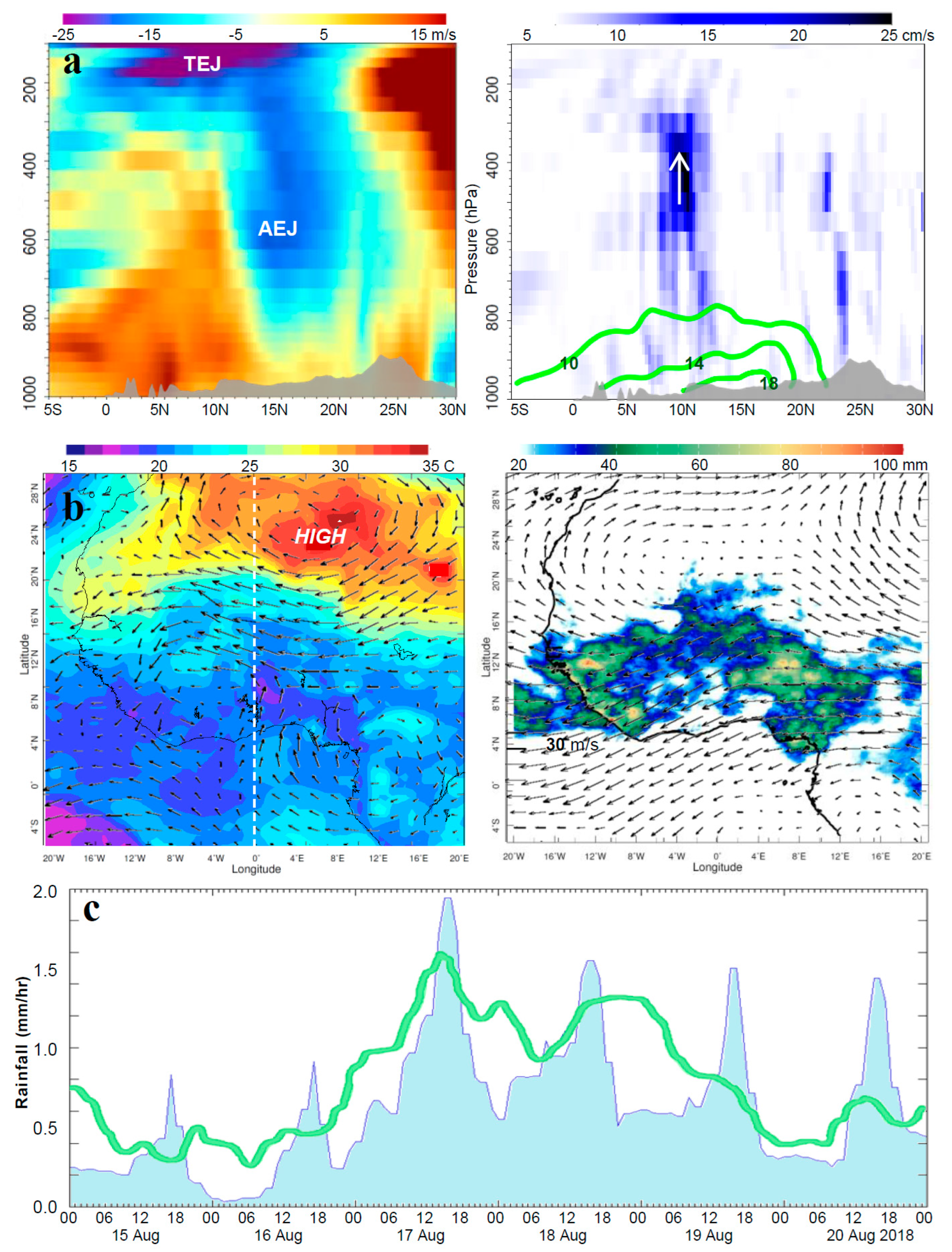
| Positive Phase | Negative Phase |
|---|---|
| India convection | India subsidence |
| TEJ surge | TEJ weak |
| AEJ linked | AEJ decoupled |
| Sahel convection | Sahel subsidence |
| Pacific La Nina | Pacific El Nino |
| Negative I.O.D. | Positive I.O.D. |
| Atlantic Nino | Atlantic Nina |
| Strong -dT/dy | Weak -dT/dy |
| Outflow from M.C. | Weak flow M.C. |
| Favorable rainfall | Inadequate rainfall |
| Surplus crop yield | Resource deficits |
Disclaimer/Publisher’s Note: The statements, opinions and data contained in all publications are solely those of the individual author(s) and contributor(s) and not of MDPI and/or the editor(s). MDPI and/or the editor(s) disclaim responsibility for any injury to people or property resulting from any ideas, methods, instructions or products referred to in the content. |
© 2025 by the author. Licensee MDPI, Basel, Switzerland. This article is an open access article distributed under the terms and conditions of the Creative Commons Attribution (CC BY) license (https://creativecommons.org/licenses/by/4.0/).
Share and Cite
Jury, M.R. Interaction of Tropical Easterly Jets over North Africa. Climate 2025, 13, 214. https://doi.org/10.3390/cli13100214
Jury MR. Interaction of Tropical Easterly Jets over North Africa. Climate. 2025; 13(10):214. https://doi.org/10.3390/cli13100214
Chicago/Turabian StyleJury, Mark R. 2025. "Interaction of Tropical Easterly Jets over North Africa" Climate 13, no. 10: 214. https://doi.org/10.3390/cli13100214
APA StyleJury, M. R. (2025). Interaction of Tropical Easterly Jets over North Africa. Climate, 13(10), 214. https://doi.org/10.3390/cli13100214





